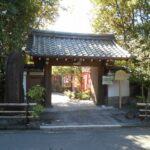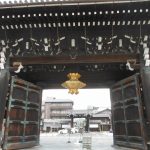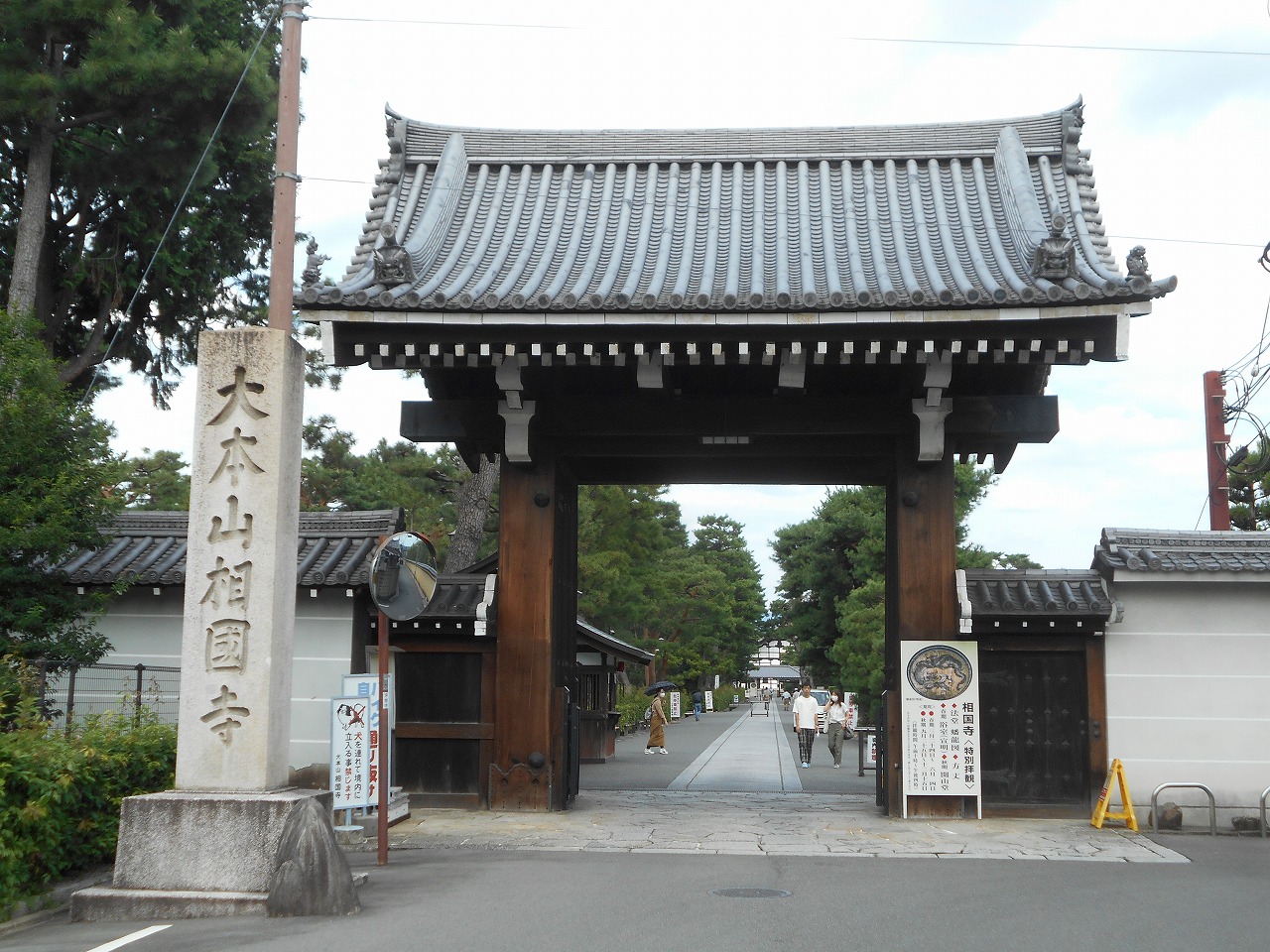
ページの目次
- Shokoku-ji Temple(相国寺)
- 1. Location-Access
- 2. Who built this temple?
- 3. What is this temple famous for ?
- 4. What is highlight ?
- 1) 総門 Sou-mon(Main gate) 京都府指定文化財
- 2) 方丈庭園 Houjyo garden 京都府指定文化財
- 3) 法堂 Hatto hall (Impotant cultural property)
- 4) 方丈 Hojyo (Abbot’s Quarters) 京都府指定文化財
- 5) 開山塔
- 6) 宣明(浴室) Senmyo(bathing room) 京都府指定文化財
- 7) 経蔵 Kyozo 京都府指定文化財
- 8) 洪音楼 Koon-ro (bell tower) 京都府指定文化財
- 9) 天響楼
- 10) 庫裏 Kuri (Priest living room) 京都府指定文化財
- 11) 弁天社 Benten-sha Shrine 京都府指定文化財
- 12) 宗旦稲荷社 Sutan Inari-sya Shrine 京都府指定文化財
- 13) 承天閣美術館 Jotenkaku Museum
Shokoku-ji Temple(相国寺)
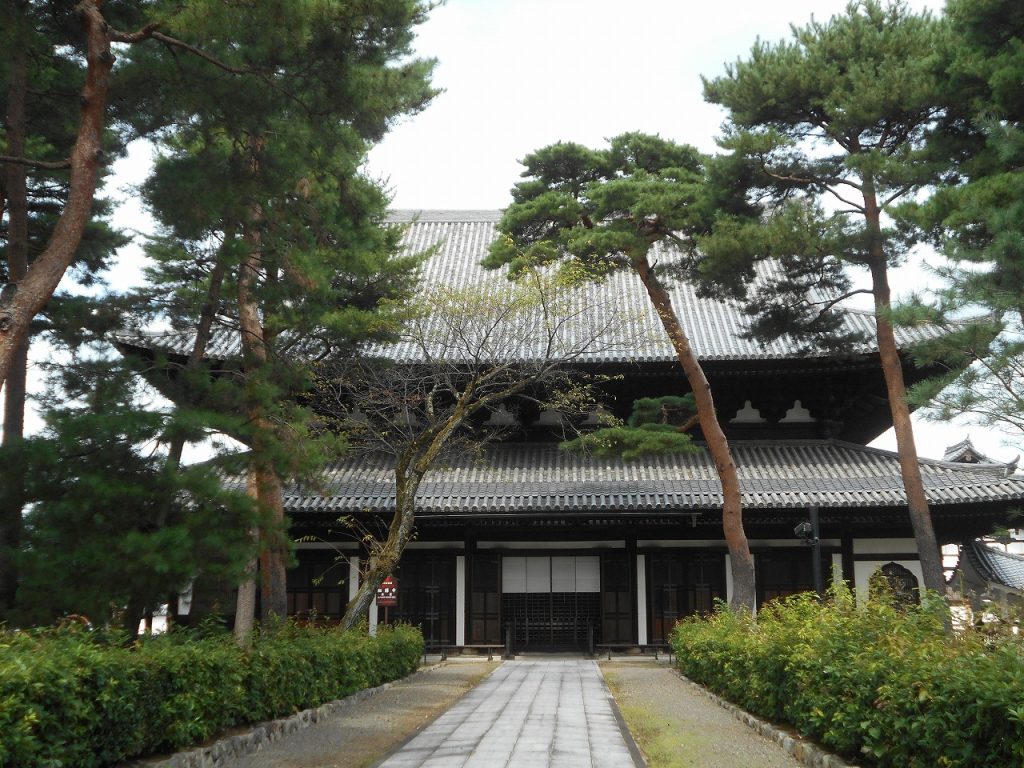
1. Location-Access
This temple is located near Doushisya University at Gosyo Area, Kyoto.
It takes 8 minutes by subway from Kyoto sta. to Imadegawa, 5-minute walk.
(この寺は、同志社大学近くの御所エリアに位置している。
地下鉄 京都駅(8分)→今出川駅、(徒歩5分)→相国寺)
2. Who built this temple?
1) In 1392, the Rinzai Sect was constructed by the 3rd Shogun Yoshimitsu Ashikaga due to the royal order from the Emperor Gokomatsu.
First priest is Musousoseki and the principality is Syaka Nyorai.
(臨済宗相国寺は、御小松天皇の勅命を受け1392年足利3代将軍義満により創建された。
開山(初代住職)は夢窓礎石で、本尊は釈迦如来である。)
2) The shodou was burned down during Ohnin wars, the temple has produced many Buddhist saint as the central for the Zen government and contributed to the rise of Zen culture in Muromachi period.
(諸堂宇は応仁の乱で焼失し、禅行政の中心地として多くの高僧を輩出し室町時代の禅文化に貢献した。)
3) In Muromachi period, this temple has been worshiped as the praying grounds for national peace and was positioned 2nd ranking of all five mountains.
Kyoto five Mountains: Exceptional Nanzen-ji, 1st Tenryu-ji, 2nd Syoukoku-ji, 3rdKennin-ji, 4th Tofuku-ji, 5th Manjyu-ji.
(室町時代の五山制度が行われると、「五山之上」という最高位に認められ、第2位と位置つけられた。 京都五山 別格:南禅寺、1位:天龍寺、2位:相国寺、3位:建仁寺、4位:東福寺、5位:万寿寺)
4) Later on, cathedral ceiling had a repair under the support of Toyotomi Family and Tokugawa Family, but it was burned down again by conflagration of Tenmei. In 1807, it was finally repaired back to the former state.
(後に豊臣氏、徳川氏の保護を受け伽藍も整備されたが、天明の大火で再び焼失した。
1807年旧官を復興するに至った。)
5) It used to be much bigger and it is said that there used to be a pagota that stood more than 100 meters high. That is almost twice as high as the five-story tower of Toji temple.
(かつてはもっと広くて、高さ100m以上の塔もあったと言われている。東寺の五重塔の2倍の高さである。)
3. What is this temple famous for ?
1) Representative Zen Temple in Japan. 日本の代表的な禅寺
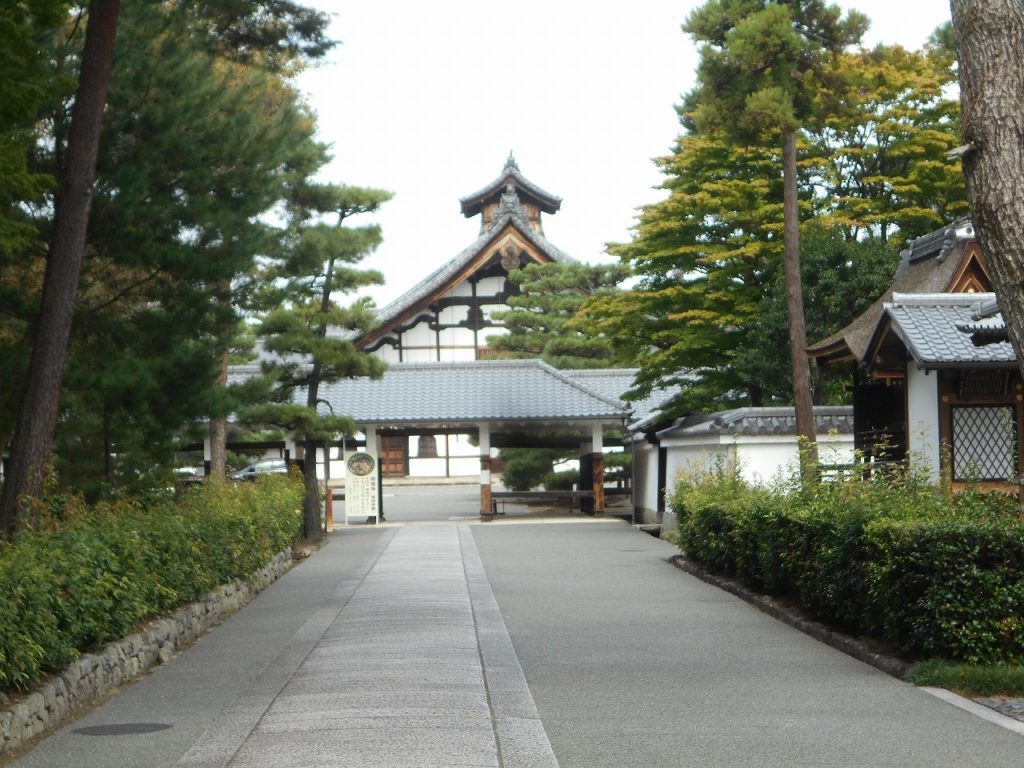
① Shokoku-ji Temple is Ashikaga’s family temple and the base of five mountain lecture
which produced famous Ink-painting high priest such as Josetsu, Syubun and Sassyu.
(足利の菩提寺であり、禅宗由来である五山文学の基点となった寺院で、如拙、周文、雪舟、など有名な画僧を輩出した。)
② There are 13 sub-temples in this temples. Kinkaku-ji Temple and Ginkaku-ji Temple are external sub-temple of Shokoku-ji Temple.
(境内には、13の塔頭寺院があるが、金閣寺、銀閣寺は相国寺の境外塔頭である。)
2) Crying dragon “Inryu Figure” ,Sugito painting and White figure 鳴き龍「幡龍図」、杉戸絵と白象図
The ceiling picture of the oldest remaining Hatto hall in Japan is “Inryu-zu” made by Kano noble and called “Naki Ryu(Crying Dragon)”. In passing Sanmon, the approach extends to sew between the pine trees and the Syoten-kaku Museum is impressive.
In autumn, we can enjoy red colored leaves from the gate to Hatto hall.
(現存する日本最古の法堂の天井画は、狩野光信作の「幡龍図」で鳴き龍とも呼ばれる
総門をくぐると、参道が松並木の間を縫うように伸びている。境内の承天閣美術館は
見ごたえ十分である。
秋になると、門から法堂までの参道は、赤く色づき紅葉を楽しむことができる。)
4. What is highlight ?
1) 総門 Sou-mon(Main gate) 京都府指定文化財
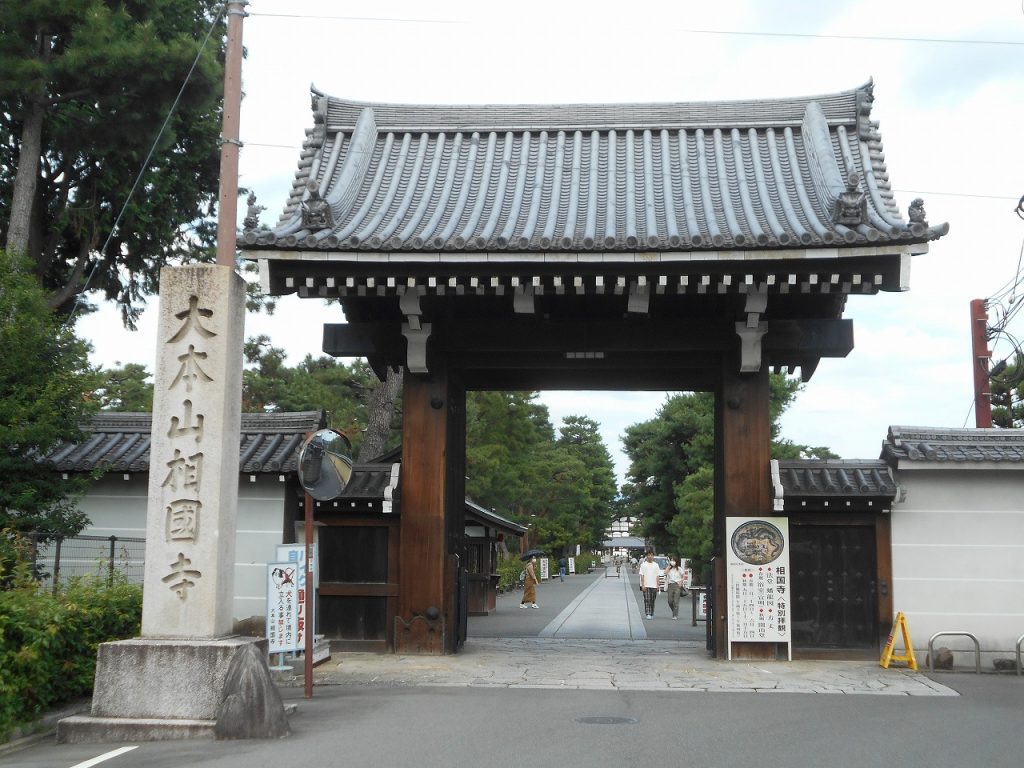
Somon was built in 1797, Edo period.
(1797年、江戸時代に再建されたものである。)
2) 方丈庭園 Houjyo garden 京都府指定文化財
This gate was built at the west of Somon, but built in do period.
(総門の西側に建てられて、江戸時代に再建されたものである。)
3) 法堂 Hatto hall (Impotant cultural property)
This building was built by the support of Hideyori, in 1605.
There is Inryu-zu made by Kano Hitunobu another name is “Crying Dragon”. It is said this is the oldest remaning Hatto building in Japan. It’s about 400 years old and painting of dragon on the ceiling is very famous building is called Hallo where Buddhist priests give lectures and so on.
(江戸時代1605年、秀頼の寄進により建てられた。天井には狩野光信作「幡龍図」が描かれていて、別名「鳴き龍」と呼ばれている。日本にある法堂で最古らしい。 400年ほどの前の
建築で天井に描かれた龍の絵が有名である。この建物は講義などが行われる法堂である。)
4) 方丈 Hojyo (Abbot’s Quarters) 京都府指定文化財
Hojo was rebuilt in 1807,Edo period. The front garden of Hojyo is specified by Kyoto Prefecture designed cultural property doe to a dry landscape garden and Chokushi-mon gate. Kannon’s paitings are Sugito’s painting called “Hokke Kannon” and white figure made by Haradaichu in Edo’s painter.
(江戸時代1807年再建されたもので、方丈前庭は枯山水庭園で方丈正面の勅使門も京都府指定文化財に指定されている。観音菩薩の絵画は、法華の観音と呼ばれている「杉戸絵」と、江戸時代の絵師である原在中に描かれた「白象図」である。
5) 開山塔
This hall was built with a dry landscape garden in 1807 and enshrined Musousoseki.
(1807年に枯山水式庭園で再建されたもので、夢窓礎石を祀っている。)
6) 宣明(浴室) Senmyo(bathing room) 京都府指定文化財
It was rebuilt in 1596, Edo period. Zen Sect is training to be bath.
(江戸時代1596年再建され、禅宗で入浴することも修行の一つである。)
7) 経蔵 Kyozo 京都府指定文化財
Kyozo was built in 1860, Edo period. (江戸時代1860年建立。)
8) 洪音楼 Koon-ro (bell tower) 京都府指定文化財
This tower was built in 1860, Edo period. (江戸時代1843年建立。)
9) 天響楼
This building was built in 2011 as a proof of friendship in Daisyokoku-ji in China.
(2011年中国の大相国寺の友好の証として建てられた。)
10) 庫裏 Kuri (Priest living room) 京都府指定文化財
Kuri was built in 1807,Edo period. (江戸時代1807年の建立)
11) 弁天社 Benten-sha Shrine 京都府指定文化財
It is enshrined Benzaiten. (弁財天を祀る弁天社である。)
12) 宗旦稲荷社 Sutan Inari-sya Shrine 京都府指定文化財
This shrine enshrined Soutan Inari-sya Shrine which is a fox traditional from this temple.
13) 承天閣美術館 Jotenkaku Museum
This museum display temple treasures.
(相国寺の寺宝を展示している美術館である。 国宝5点、重要文化財143点)
